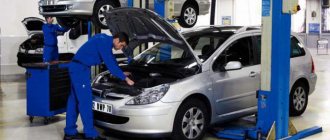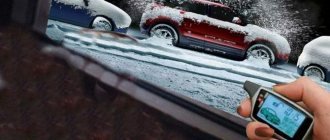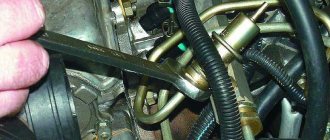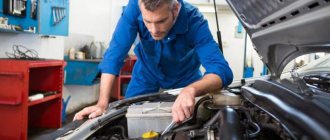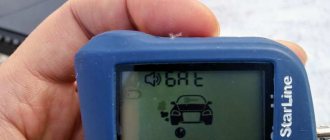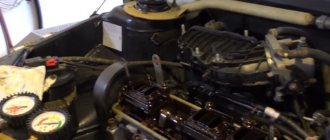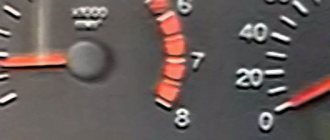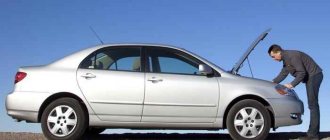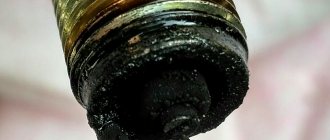Why does the car jerk?
There can be simply a huge number of problems due to which a car can drive jerkily (twitch), and they are individual for each car. These could be problems with the fuel system or transmission problems. Let's look at each of the reasons.
Fuel problems
Problems related to fuel supply to the engine.
Gasoline pump
All cars with injection engines are equipped with a fuel pump that pumps pressure into the fuel system. The normal operating pressure of the pump reaches 10 kg/cm³. Over time, the pump may lose its former power due to aging or dirty filters, fine and coarse fuel cleaning, which will undoubtedly lead to a loss of pressure and improper operation of the internal combustion engine.
Injectors
Another important indicator in the fuel system is the injectors. They spray fuel into the engine cylinder head, mixing it with air and feeding it into the combustion chamber. Over time, the injector nozzle becomes clogged with dirt and carbon deposits, which contributes to incorrect and even insufficient fuel atomization, which leads to uneven operation of the entire internal combustion engine.
Ignition problems
Problems associated with the formation of a spark in the engine.
Candles
To ignite the fuel mixture in a car, spark plugs are used, which produce sparks in the combustion chamber, thereby igniting the air-fuel mixture. Over time, due to the low quality of fuel, which is abundant in the vast expanses of the Russian Federation, spark plugs become covered with soot or, due to exposure to high temperatures, change their gap, which leads to improper operation of the internal combustion engine.
Wires
Spark plug wires also play an important role in engine operation; they transmit high voltage from the coil to the spark plug. The insulation of these wires is made of silicone and, under the influence of high temperatures and time, is subject to drying out and, consequently, cracks. High voltage, passing through a wire with a crack, can make its way to the body and thus does not even reach the spark plug, this is especially noticeable at high speeds and when the car is running under load.
Reels
The ignition module is the element that produces a spark to the cylinders; when it fails, the cylinders fail, but it often happens that the module can turn off due to temperature or load. By the way, the ignition module is no longer available in more modern cars; it was replaced by individual ignition coils, which helped get rid of wires and their problems. The IKZ is put directly on the spark plug and produces a spark for exactly one cylinder in which it is installed.
Transmission problems
Problems related to the gearbox, drives and wheels.
checkpoint
The gearbox is responsible for moving the car. Breakdowns are possible very often, especially if it is a rather complex automatic transmission, in which you have to frequently change the oil and monitor its quality. Failures in the gearbox can be in bearings, shafts, or clutches.
Drive
Car drives or cardans, which transmit rotation from the gearbox to the wheels, can also be the reason why the car jerks. Wear of constant velocity joints can create backlash between the gearbox and the wheel, which will lead to jerking. It’s the same with the cardan transmission, whether it’s on a crosspiece or a CV joint, its wear promises knocks and jerks.
Wheels
Wheels that have uneven wear, namely ellipse, can create jerks on the car when it moves at a certain speed, this is most noticeable on a flat road at a speed of 40 km/h.
Bottom line
Even the most careful and thrifty driver is not insured against car breakdown. This is influenced by many factors beyond the driver's control. The quality of the assembly, the reliability of the installed parts, the correct calculations of the engineers, the condition of the roads, the duration and intensity of operation and even climatic conditions. But every car owner must maintain the working condition of the car. And if you stubbornly ignore his “complaints” and continue driving, then you can finally “kill” him.
Of course, you can try to “reanimate” him, but this could cost quite a lot of money. Moreover, the reasons why a car may twitch are on the surface. Spark plugs, clutch, filters - small parts that lead to big problems. Find time and some money to take your car for diagnostics. She needs it regularly, like a person visiting a hospital. For proper car care, you will be rewarded with many years of faithful service!
Add ProCrossovers to your favorites
The computer is a common cause of traffic problems
The first two factors are the most common reasons why a car jerks when driving. But there is also a hidden problem, which is usually discovered after repairing the gearbox, replacing spark plugs and all kinds of filters. This is a computer and an installed program. This problem inevitably befalls owners of budget cars.
The fact is that the programs embedded in car computers are designed for ideal engine operation. As soon as one of the cylinders gets a little worn, the engine starts to run rough. There is only one way to solve this problem:
- contact an official or specialized service center;
- test the operation of the installed program (firmware);
- rewrite a more universal program for your car;
- Test the operation of the machine after performing this procedure.
Many automotive technicians recommend using this procedure before performing any other repair work. It is often very difficult to determine whether a computer is involved in problems, because it is impossible to diagnose the operation of the program itself.
Video:
If, even after changing the firmware, no positive changes occur, the car still jerks when driving, then a more complete diagnosis and replacement of certain components is necessary. It is important not to buy any expensive units or order expensive work before checking the operation of the computer.
Repair
In most cases, parts that were found to be inoperable during diagnostic procedures must be replaced. However, candles can be soaked in acetone and heated on a gas burner. In some cases, this helps to temporarily restore their functionality. The gas filter, if this is the cause, can be removed from the system for a short time by replacing it with the insert of a rubber gas-resistant hose on clamps. However, such measures are only permissible for a short time to get to repairs. In turn, a faulty fuel pump membrane on carburetor cars can also be temporarily replaced with several layers of a regular plastic bag. However, if the car is still able to move, it is better to get to the repair site “as is”. Detected places of air leakage, bypassing the main line, as well as places of fuel leakage, are carefully sealed. Damaged fuel lines and air lines of carburetor cars can be temporarily wrapped with several layers of electrical tape. Fuel lines of injection cars are not subject to such repairs due to the high operating pressure in them. Threaded and clamp connections are additionally stretched. It is necessary to set the timing phases in accordance with the instructions for each individual car model. On front-wheel drive VAZ models, this procedure is performed by aligning the crankshaft and camshaft pulley marks with the timing belt removed or loosened.
Do you have a question or comment?
Write! Click to cancel reply.
Correct operation of the injector
There are a few simple tips, but if you follow them carefully, you will not experience any jerking of the car while driving, and the injector will always be in good condition:
- Never remove the terminals from the battery while the engine is running, as this may cause the injector to malfunction.
- If you have a catalytic converter installed, it is prohibited to start the engine by traction ("push").
- Make sure that no water gets into the injection system - this is guaranteed to lead to malfunction of the injectors, fuel pump and filter.
- When reinstalling the neutralizer and lambda probe, refueling with leaded gasoline is prohibited. This can lead to a malfunction of the electronic control unit and overfilling of the injector with the combustible mixture.
- And the most important thing. Never fill your car with questionable gasoline. Bad fuel leads to contamination of the fuel filter, pump and injection system.
The most obvious thing is injection problems
It often happens that a relatively new and, at first glance, fully functional car, which starts well in hot weather, jerks when driving. There can be many reasons for this behavior of a vehicle, but there is one, perhaps the main one. Most likely your car has an injection problem . Of course, the problem will not be solved by itself and you will need to diagnose the injectors.
Diagnostics of self-injectors is not very difficult and the procedure is only possible if you have the necessary technical equipment. You will need:
- Microcomputer with engine diagnostic function.
- Compressor is a device for creating compression in cylinders.
- Pressure gauge for measuring fuel pressure level. This is necessary to diagnose a malfunction of the pressure regulator, fuel pump or clogged fuel filters.
- An ohmmeter is needed to measure battery voltage.
- LED probe.
However, most of the listed devices can be easily dispensed with. For high-quality diagnostics of injector operation an on-board computer that can read faults is sufficient.
So we connect the microcomputer to the engine, run the test and wait for the results. You will likely have many different metrics. However, if the car jerks strongly, but moves and starts normally, most likely nothing bad has happened to the injector. Most likely, simple cleaning of the injectors is necessary.
However, if diagnostics does not present any particular problems, then cleaning it is somewhat more complicated.
Malfunctions in the air supply system and sensors
Vehicles with injection engines are equipped with an ECU. In other words, the system monitors all processes and issues error codes. When excess air is sucked in, the ECU loses control over the amount of air supplied. From which it follows that instead of an enriched mixture, a lean mixture will be supplied to the engine. Of course, this is a loss of power when accelerating and jerking the engine. Therefore, it is necessary to search for the place of depressurization and eliminate the problem.
The reason for the car jerking when accelerating may be the incorrect operation of some sensors. There are many of them in modern cars. So, let's get acquainted with the main ones that can create a problem with the engine during acceleration:
- malfunction of the throttle position sensor TPS;
- breakdown of the camshaft position sensor (DPRV) and DPKV;
- Problems with the mass air flow sensor.
Video about jerks during acceleration
Sooner or later, every car enthusiast encounters this phenomenon: the engine suddenly starts running jerkily, the car seems to twitch. This can happen at any time. When accelerating, sharply pressing the gas pedal and even at idle. We will talk about why this happens and how to deal with it in this article.
